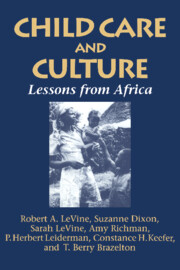Book contents
- Frontmatter
- Contents
- List of tables and figures
- Foreword
- Acknowledgments
- Introduction
- Part I African infancy: Frameworks for understanding
- 1 The comparative study of child care
- 2 Infant care in sub-Saharan Africa
- Part II Parenthood among the Gusii of Kenya
- Part III Infant care and development in a Gusii community
- Part IV Interpretations
- Appendix A Fieldwork procedures: Initial phases and planning
- Appendix B Coding categories for spot observations
- Appendix C Blankhart Nutrition Questionnaire
- Appendix D Temperament Assessment Method
- Appendix E Coding categories for narrative observations
- Appendix F Coding categories for face-to-face interaction
- Appendix G Coding categories for maternal teaching task
- Appendix H Supplementary tables
- Notes
- References
- Index
- Plate section
2 - Infant care in sub-Saharan Africa
from Part I - African infancy: Frameworks for understanding
Published online by Cambridge University Press: 11 May 2010
- Frontmatter
- Contents
- List of tables and figures
- Foreword
- Acknowledgments
- Introduction
- Part I African infancy: Frameworks for understanding
- 1 The comparative study of child care
- 2 Infant care in sub-Saharan Africa
- Part II Parenthood among the Gusii of Kenya
- Part III Infant care and development in a Gusii community
- Part IV Interpretations
- Appendix A Fieldwork procedures: Initial phases and planning
- Appendix B Coding categories for spot observations
- Appendix C Blankhart Nutrition Questionnaire
- Appendix D Temperament Assessment Method
- Appendix E Coding categories for narrative observations
- Appendix F Coding categories for face-to-face interaction
- Appendix G Coding categories for maternal teaching task
- Appendix H Supplementary tables
- Notes
- References
- Index
- Plate section
Summary
The conditions under which infants are raised in sub-Saharan Africa have been explored by anthropologists, demographers, and developmental psychologists. Despite the large size of the continent and the diversity of its inhabitants, the sub-Saharan agricultural peoples are connected by history as well as geography and constitute a distinct cultural region in comparison with other regions of the world. Many Gusii customs are shared with other peoples in the region. This chapter sets the stage for our consideration of the Gusii case by describing similarities and variations in African practices of infant care, beginning with the goal of survival and proceeding to the organizational and relational contexts of caregiving, its characteristic activities and interactions, and patterns of early development.
SURVIVAL AS A GOAL OF INFANT CARE
African customs of infant care have been described in the anthropological literature since at least the beginning of the 20th century. The earliest observers were Protestant missionaries who worked among Bantu peoples in southern Africa before 1920. Their published accounts are not focused on childhood but include descriptions of customs in which babies are breast-fed for 2 or 3 years, carried on their mothers' backs, and often taken care of by young girls – whose photographs with babies bound to their backs appear in some of the books. The great frequency of infant death is mentioned, often as an aside. Birth rituals, naming ceremonies, and vernacular terms for the early stages of childhood are described, usually with no interpretation.
- Type
- Chapter
- Information
- Child Care and CultureLessons from Africa, pp. 22 - 54Publisher: Cambridge University PressPrint publication year: 1994
- 2
- Cited by

